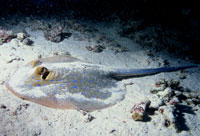  Fun Stingray Facts for Kids Fun Stingray Facts for Kids
Check out our range of fun stingray facts for kids. Learn about the stingrays defenses against predators, what stingrays eat, where they live, how many species there are, and much more. Read on and enjoy our interesting information about stingrays. | | |
Like their cousin the shark, stingrays do not have bones, their skeletons are instead made of cartilage. Stingrays are a group of rays, consisting of eight families including the sixgill stingray, deep water stingray, stingarees, round rays, whiptail stingrays, river stingrays, butterfly rays and eagle rays. There are around 70 species of stingrays in the world. Stingrays are commonly found in tropical and subtropical coastal ocean waters, a few species live in freshwater rivers. Most varieties of stingrays have one or more barbed venomous stingers on their tail which are only used in self-defence. Stingrays flat bodies allow them to dig in and hide from predators on the sandy ocean bottom. The main predators of stingrays are sharks, other large fish, seals, and sea lions. Stingrays eyes are on top of their bodies, yet their mouth, gills, and nostrils are on the underside. Because of this stingrays cannot see their prey, instead they use smell and electroreceptor's to find food. Stingrays mainly feed on molluscs, crustaceans such as crabs, clams, oysters, sea snails and small fish. To swim, some stingray species flap their fins like a bird and fly through the water, others move their entire bodies in a wavy motion propelling them forward. Shuffling your feet along a sandy shallow sea floor is the best way to avoid stepping on a stingray and potentially getting stung. In the wild, a stingray can live on average to be 15 to 25 years old. Some species of stingray found in the deep ocean can grow as long as 14 ft including the tail. Stingrays are eaten in many cuisines around the world. In Singapore and Malaysia, stingray is grilled over charcoal, and served with spicy sauces. The leathery skin of the ray is often used to make exotic shoes, boots, belts, wallets, jackets, and cellphone cases. In Japan, the skin is sometimes used as an under layer on Japanese swords due to its hard, rough, texture that keeps the layer on top from sliding on the handle during use.
| 
|
|